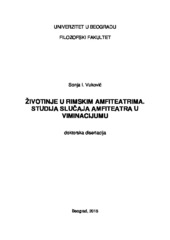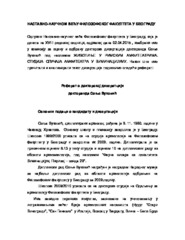Приказ основних података о дисертацији
Životinje u rimskim amfiteatrima
Animals in Roman amphitheatres: studija slučaja amfiteatra u Viminacijumu
| dc.contributor.advisor | Dimitrijević, Vesna | |
| dc.contributor.other | Korać, Miomir | |
| dc.contributor.other | Vujović, Miroslav | |
| dc.creator | Vuković, Sonja | |
| dc.date.accessioned | 2016-03-09T09:26:42Z | |
| dc.date.available | 2016-03-09T09:26:42Z | |
| dc.date.available | 2020-07-03T10:01:34Z | |
| dc.date.issued | 2015-06-12 | |
| dc.identifier.uri | https://nardus.mpn.gov.rs/handle/123456789/4847 | |
| dc.identifier.uri | http://eteze.bg.ac.rs/application/showtheses?thesesId=2494 | |
| dc.identifier.uri | https://fedorabg.bg.ac.rs/fedora/get/o:10531/bdef:Content/download | |
| dc.identifier.uri | http://vbs.rs/scripts/cobiss?command=DISPLAY&base=70036&RID=525744535 | |
| dc.description.abstract | Disertacija obuhvata proučavanje spektakala sa životinjama, koji su se održavali u rimskim amfiteatrima, upoređivanjem podataka iz arheozooloških, arheoloških i pisanih svedočanstava. Istraživači, koji su se bavili fenomenom životinja u rimskim spektaklima, do sada su bazirali svoja istraživanja na podacima iz istorijskih izvora i prikaza na spomenicima, dok su rezultati arheozoološke analize retko uključeni u ova istraživanja. U tekstovima antičkih pisaca naveden je veliki broj egzotičnih i autohtonih divljih i domaćih životinja, koje su učestvovale u spektaklima. Spektakli su uključivali međusobne borbe životinja, borbe životinja sa gladijatorima (venatores), egzekucije osuđenika od strane životinja (damnatio ad bestias) i inscenacije lova na životinje, ali i predstave egzotičnih životinja i zabavne tačke koje su one izvodile. Na brojnim arheološkim spomenicima širom rimskog Carstva predstavljene su životinje u igrama u amfiteatru. Pisana svedočanstva o spektaklima sa životinjama odnose se na dešavanja u Koloseumu, dok podaci o igrama u drugim amfiteatrima, uglavnom, ne postoje. Glavni ciljevi ove teze su da se utvrdi: • koje životinje su korišćene u spektaklima širom Carstva • šta predstavljaju ostaci životinja u rimskim amfiteatrima • da li postoji veza između faunističkih ostataka iz rimskih amfiteatara i životinja, koje su učestvovale u spektaklima. Iako je na prostoru Carstva posvedočeno prisustvo preko 250 amfiteatara, broj objavljenih faunističkih izveštaja iz rimskih amfiteatara je neuporedivo manji. U tezi su analizirani dostupni faunistički podaci iz amfiteatara u Rimu, Virnumu, Augusti Raurici, Silčesteru, Česteru, Londonu, Sarmisegetuzi i Serdici, dok su ostaci životinja iz perioda korišćenja amfiteatra u Viminacijumu analizirani kao studija slučaja. Međusobnim upoređivanjem faunističkih podataka iz rimskih amfiteatara, zaključeno je da oni uglavnom predstavljaju ostatke svakodnevnih aktivnosti (hrane, mesarskog otpada) i da ne postoji bitna razlika između ovih nalazišta u procentualnom udelu najzastupljenijih životinja (govečeta, svinje, ovce i koze). Međutim, kada je u pitanju zastupljenost potencijalnih učesnika spektakla, pre svega divljih i egzotičnih životinja, zapažaju se razlike. Najveći broj egzotičnih životinja pronađen je u Koloseumu, dok se po broju različitih vrsta divljih životinja, koje su mogle da učestvuju u spektaklu, izdvajaju amfiteatri u Virunumu i u Viminacijumu. Upoređivanjem arheozooloških podataka iz rimskih amfiteatara sa podacima o spektaklima sa životinjama, koji su poznati iz pisanih dokumenata i arheološke građe, potvrđena je hipoteza da su u amfiteatrima širom Carstva uglavnom korišćene autohtone životinje, dok su se u Koloseumu i drugim većim amfiteatrima, uz autohtone, na programima spektakala mogle naći i egzotične životinje. Budući da postoji velika razlika između broja i raznovrsnosti životinja, koje su navedene u tekstovima antičkih pisaca, i broja pronađenih kostiju egzotičnih životinja, zaključeno je da je u podacima, koji su navedeni u izvorima bilo preuveličavanja. Tokom novih iskopavanja amfiteatra u Viminacijumu, otkrivena je značajna količina životinjskih kostiju, koja se na osnovu konteksta nalaza može opredeliti u period korišćenja ovog amfiteatra. Od kostiju, uz ostatke domaćih životinja, koje su korišćene u svakodnevnom životu na Viminacijumu (goveče, svinja, ovca, koza, ekvidi, pas, kamila, mačka, kokoška, guska, patka), otkriveni su ostaci medveda, jelena, divljih svinja i drugih divljih životinja. Pojava kostiju divljih životinja među faunističkim ostacima iz rimskih amfiteatara postavila je pitanje da li te kosti predstavljaju ostatke životinja, koje su nekada učestvovale u spektaklima. Odgovor je podrazumevao tumačenje načina na koji se postupalo sa posmrtnim ostacima životinja iz amfiteatara. Prilikom rekonstrukcije tretmana životinja nakon smrti u amfiteatru, krenulo se od hipoteze D. Kajla (Kyle 2001), da su korišćeni meso i drugi proizvodi ubijenih životinja (krzno, koža, rogovi). Postoji i pretpostavka da su celi skeleti ubijenih životinja bili bačeni na deponiju, koja do sada nije otkrivena. U ovom kontekstu proučavane su specifičnosti na kostima divljih životinja iz viminacijumskog amfiteatra (zastupljenost delova skeleta, obrasci kasapljenja, tragovi tafonomskih procesa), koje su, prema pisanim svedočanstvima, mogle da učestvuju u spektaklima. Retki istorijski izvori, u kojima se nalaze podaci o postupanju sa trupovima životinja i o eventualnoj konzumaciji mesa zveri, korišćeni su prilikom rešavanja ovog problema. Zaključeno je da, iako postoje direktni podaci o konzumaciji mesa i iskorišćavanju kože, krzna i rogova ovih životinja, ne može se odrediti da li kosti predstavljaju ostatke jedinki, koje su učestvovale u spektaklu, ili jedinki, koje su isključivo ulovljene zbog eksploatacije navedenih proizvoda. Ukoliko je došlo do procesuiranja leševa životinja iz amfiteatara u blizini ovog objekta, neki delovi tela su mogli biti bačeni nedaleko od amfiteatra, dok su neki delovi verovatno odneti sa ovog prostora, kako bi završili na trpezi, ili kako bi se dalje prerađivali. Ostaci mesa ovih životinja mogli su da budu bačeni na deponiju u blizini amfiteatra. Prilikom prepravki na amfiteatru, zemlja za nasip verovatno je donošena iz blizine amfiteatra, a postoji mogućnost da su se u toj zemlji, uz različite ostatke životinja, našle i kosti životinja, koje su nekada učestvovale u spektaklu u viminacijumskom amfiteatru. | sr |
| dc.description.abstract | This thesis discusses animal spectacles in roman amphitheatres, by combining archaeozoological, ancient textual and artistic data. Until now, studies that dealt with this subject were mainly focused on textual and archaeological data, while less attention was paid to animal bone analysis. According to numerous descriptions in ancient texts, a large number of both exotic and autochthonous wild and domestic animals participated in amphitheatre shows. These spectacles included: fights between animals, fights between animals and gladiators (venatores), execution of criminals by using dangerous animals, hunting animals and also presentations of exotic animals and entertainment provided by performing animals. Scenes of animal shows are presented on numerous archaeological finds. Ancient texts mainly describe shows that went on in the Colosseum, while data on animal shows in other amphitheatres are scarce. The main goal of the thesis is to determine: • Which animals participated in shows throughout different amphitheatres in the Roman world; • What animal remains found in Roman amphitheatres actually are; • Whether there is any connection between animal remains from the amphitheatres and animals that participated in spectacles. There are more than 250 known amphitheatres throughout the Roman world. However, there are only few amphitheatres with published animal bone results. In this thesis animal bone data from roman amphitheatres in Rome, Virunum, Augusta Raurica, Silchester, Chester, London, Sarmisegetusa and Serdica are discussed, while animal remains from Viminacium amphitheatre are analysed as a case study. The comparison of animal bone data from different amphitheatres revealed that animal remains mainly present the remnants of everyday activities, such as food and butchery waste. It is also concluded that there is not any significant difference in presence of the most common species (cattle, pig, sheep and goat) among faunal material between Roman amphitheatres and also other contemporaneous sites. However, there is a difference in the representation of the exotic and wild animal remains, potential participants of spectacles. Exotic species were mostly found within Colosseum, while the most diverse species of game animals have been found, apart from Rome in amphitheatres of Virnum and Viminacium. Comparison of faunal data from Roman amphitheatres and data on spectacles in ancient texts and archaeological finds confirmed the assumption that mainly autochthonous animals participated in amphitheatres throughout the Roman world, while in the Colosseum and other great amphitheatres besides local, exotic animals were also put on shows. Since there is a huge difference between the diversity and the number of mentioned exotic animals mentioned in texts and the the actual number of exotic animal finds, it is concluded that ancient writers used to exaggerate in their descriptions. In the course of the excavations of the Roman amphitheatre in Viminacium, a great number of animal bones have been unearthed that date back to the period of the utilization of the amphitheatre. Along with remains of domestic animals, such as cattle, pig, sheep, goat, equids, camel, cat, chicken, goose and duck, remains of brown bear, red deer, wild boar and other wild animals have also been found. Findings of animal bones in Roman amphitheatres, which according to ancient texts were used in shows, raise the question whether those animal remains originate from animals which participated in the spectacles. The answer lies in the interpretation of the way animal carcasses after their death in the arena were treated. The hypothesis set by D. Kyle that meat and other animal products from killed animals were used is widely accepted. However, the suggestion that those carcasses were taken away and dumped outside the city cannot be ruled out either, although such dumps have not been found yet. In order to understand the treatment of animal carcasses, characteristics of wild animal remains from Viminacium amphitheatre (element abundance, butchery patterns, taphonomy) have been analyzed. There are also a few ancient texts that deal with this subject and they were also incorporated in the study. It is concluded that although there is evidence that meat, fur, hide, antlers and other products originating from animals that could have been used in shows were exploited, it is not possible to determine whether wild animal remains belonged to the animals used in shows or the animals hunted solely for meat and fur. If animal corpses used to be processed close to the amphitheatre, some skeletal parts could have been dumped in the vicinity, while other elements were probably taken away either to be eaten (for food), or for further processing (fur, hide and antler). Food waste from those animals could have been dumped in the vicinity of the amphitheatre. In the course of rebuilding of the amphitheatre by filling up of the embankment of the stands, it is also possible that remains of animals once used to participate in games were dumped together with the soil used as the embankment filling. | en |
| dc.format | application/pdf | |
| dc.language | sr | |
| dc.publisher | Универзитет у Београду, Филозофски факултет | sr |
| dc.relation | info:eu-repo/grantAgreement/MESTD/Integrated and Interdisciplinary Research (IIR or III)/47001/RS// | |
| dc.rights | openAccess | en |
| dc.rights.uri | https://creativecommons.org/licenses/by-nc-nd/4.0/ | |
| dc.source | Универзитет у Београду | sr |
| dc.subject | arheozoologija | sr |
| dc.subject | archaeozoology | en |
| dc.subject | antički period | sr |
| dc.subject | spektakli sa životinjama | sr |
| dc.subject | venatio | sr |
| dc.subject | amfiteatri | sr |
| dc.subject | Viminacium | sr |
| dc.subject | Roman period | en |
| dc.subject | animal spectacles | en |
| dc.subject | venatio | en |
| dc.subject | amphitheatres | en |
| dc.subject | Viminacium | en |
| dc.title | Životinje u rimskim amfiteatrima | sr |
| dc.title | Animals in Roman amphitheatres: studija slučaja amfiteatra u Viminacijumu | en |
| dc.type | doctoralThesis | en |
| dc.rights.license | BY-NC-ND | |
| dcterms.abstract | Димитријевић, Весна; Кораћ, Миомир; Вујовић, Мирослав; Вуковић, Соња; Животиње у римским амфитеатрима; Животиње у римским амфитеатрима; | |
| dc.identifier.fulltext | https://nardus.mpn.gov.rs/bitstream/id/27015/Vukovic_Sonja_I.pdf | |
| dc.identifier.fulltext | http://nardus.mpn.gov.rs/bitstream/id/27014/Disertacija453.pdf | |
| dc.identifier.fulltext | http://nardus.mpn.gov.rs/bitstream/id/27015/Vukovic_Sonja_I.pdf | |
| dc.identifier.fulltext | https://nardus.mpn.gov.rs/bitstream/id/27014/Disertacija453.pdf | |
| dc.identifier.rcub | https://hdl.handle.net/21.15107/rcub_nardus_4847 |



